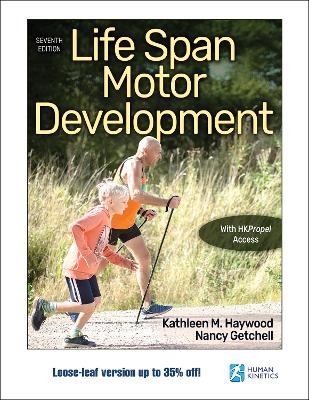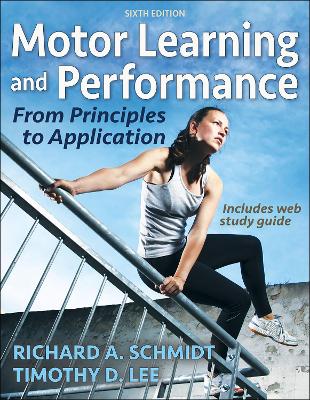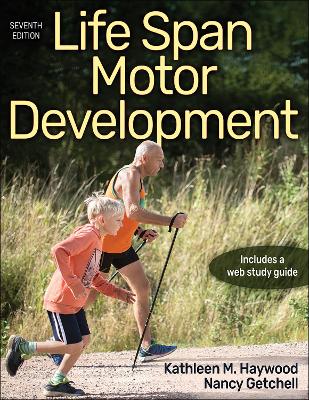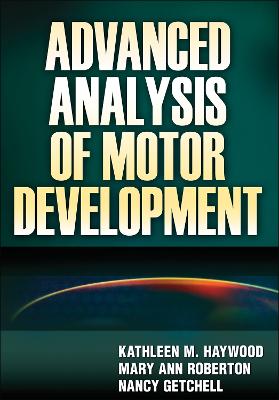Life Span Motor Development
 -15%
portes grátis
-15%
portes grátis
Life Span Motor Development
Getchell, Nancy; Haywood, Kathleen
Human Kinetics Publishers
05/2019
448
Loose-leaf
Inglês
9781492587248
15 a 20 dias
1247
Descrição não disponível.
Part I. Introduction to Motor Development
Chapter 1. Fundamental Concepts
Defining Motor Development
Constraints: A Model for Studying Motor Development
How Do We Know It Is Change?
A Developmental Paradox: Universality Versus Variability
Summary and Synthesis
Chapter 2. Theoretical Perspectives in Motor Development
Maturational Perspective
Information Processing Perspective
Ecological Perspective
Current Interests
Summary and Synthesis
Chapter 3. Principles of Motion and Stability
Understanding the Principles of Motion and Stability
Using the Principles of Motion and Stability to Detect and Correct Errors
Summary and Synthesis
Part II. Development of Motor Skills Across the Life Span
Chapter 4. Early Motor Development
How Do Infants Move?
Why Do Infants Move? The Purpose of Reflexes
Motor Milestones: The Pathway to Voluntary Movements
Development of Postural Control and Balance in Infancy
Summary and Synthesis
Chapter 5. Development of Human Locomotion
The First Voluntary Locomotor Efforts: Creeping and Crawling
Walking Across the Life Span
Running Across the Life Span
Other Locomotor Skills
Summary and Synthesis
Chapter 6. Development of Ballistic Skills
Overarm Throwing
Kicking
Punting
Sidearm Striking
Overarm Striking
Interventions
Summary and Synthesis
Chapter 7. Development of Manipulative Skills
Grasping and Reaching
Catching
Anticipation
Summary and Synthesis
Part III. Physical Growth and Aging
Chapter 8. Physical Growth, Maturation, and Aging
Prenatal Development
Postnatal Development
Summary and Synthesis
Chapter 9. Development and Aging of Body Systems
Systems Development During the Prenatal Period
Systems Development During Childhood and Adolescence
Systems Development During Adulthood
Summary and Synthesis
Part IV. Development of Physical Fitness
Chapter 10. Development of Cardiorespiratory Endurance
Physiological Responses to Short-Term Exercise
Physiological Responses to Prolonged Exercise
Summary and Synthesis
Chapter 11. Development of Strength and Flexibility
Muscle Mass and Strength
Development of Flexibility
Summary and Synthesis
Chapter 12. Weight Status, Fitness, and Motor Competence
A Model of Interrelationships
Body Composition
Obesity
Motor Competence, Activity, Fitness, and Body Composition
Summary and Synthesis
Part V. Perceptual-Motor Development
Chapter 13. Sensory-Perceptual Development
Visual Development
Kinesthetic Development
Auditory Development
Intermodal Perception
Summary and Synthesis
Chapter 14. Perception and Action in Development
The Role of Action in Perception
Postural Control and Balance
Summary and Synthesis
Part VI. Functional Constraints in Motor Development
Chapter 15. Social and Cultural Constraints in Motor Development
Social and Cultural Influences as Environmental Constraints
Other Sociocultural Constraints: Race, Ethnicity, and Socioeconomic Status
Summary and Synthesis
Chapter 16. Psychosocial Constraints in Motor Development
Self-Esteem
The Link Between Perceived and Actual Motor Competency
Motivation
Summary and Synthesis
Chapter 17. Developmental Motor Learning
Unpacking the Definition of "Motor Learning"
A Brief History of Developmental Motor Learning
Stages of Learning and the Development of Expertise
Practice and Motor Learning
Augmented Feedback and Motor Learning
Other Factors that Impact Motor Learning
Summary and Synthesis
Chapter 18. Conclusion: Interactions Among Constraints
Using Constraints to Enhance Learning in Physical Activity Settings
Interacting Constraints: Case Studies
Summary and Synthesis
Appendix. Skinfold, Body Mass Index, and Head Circumference Charts
Chapter 1. Fundamental Concepts
Defining Motor Development
Constraints: A Model for Studying Motor Development
How Do We Know It Is Change?
A Developmental Paradox: Universality Versus Variability
Summary and Synthesis
Chapter 2. Theoretical Perspectives in Motor Development
Maturational Perspective
Information Processing Perspective
Ecological Perspective
Current Interests
Summary and Synthesis
Chapter 3. Principles of Motion and Stability
Understanding the Principles of Motion and Stability
Using the Principles of Motion and Stability to Detect and Correct Errors
Summary and Synthesis
Part II. Development of Motor Skills Across the Life Span
Chapter 4. Early Motor Development
How Do Infants Move?
Why Do Infants Move? The Purpose of Reflexes
Motor Milestones: The Pathway to Voluntary Movements
Development of Postural Control and Balance in Infancy
Summary and Synthesis
Chapter 5. Development of Human Locomotion
The First Voluntary Locomotor Efforts: Creeping and Crawling
Walking Across the Life Span
Running Across the Life Span
Other Locomotor Skills
Summary and Synthesis
Chapter 6. Development of Ballistic Skills
Overarm Throwing
Kicking
Punting
Sidearm Striking
Overarm Striking
Interventions
Summary and Synthesis
Chapter 7. Development of Manipulative Skills
Grasping and Reaching
Catching
Anticipation
Summary and Synthesis
Part III. Physical Growth and Aging
Chapter 8. Physical Growth, Maturation, and Aging
Prenatal Development
Postnatal Development
Summary and Synthesis
Chapter 9. Development and Aging of Body Systems
Systems Development During the Prenatal Period
Systems Development During Childhood and Adolescence
Systems Development During Adulthood
Summary and Synthesis
Part IV. Development of Physical Fitness
Chapter 10. Development of Cardiorespiratory Endurance
Physiological Responses to Short-Term Exercise
Physiological Responses to Prolonged Exercise
Summary and Synthesis
Chapter 11. Development of Strength and Flexibility
Muscle Mass and Strength
Development of Flexibility
Summary and Synthesis
Chapter 12. Weight Status, Fitness, and Motor Competence
A Model of Interrelationships
Body Composition
Obesity
Motor Competence, Activity, Fitness, and Body Composition
Summary and Synthesis
Part V. Perceptual-Motor Development
Chapter 13. Sensory-Perceptual Development
Visual Development
Kinesthetic Development
Auditory Development
Intermodal Perception
Summary and Synthesis
Chapter 14. Perception and Action in Development
The Role of Action in Perception
Postural Control and Balance
Summary and Synthesis
Part VI. Functional Constraints in Motor Development
Chapter 15. Social and Cultural Constraints in Motor Development
Social and Cultural Influences as Environmental Constraints
Other Sociocultural Constraints: Race, Ethnicity, and Socioeconomic Status
Summary and Synthesis
Chapter 16. Psychosocial Constraints in Motor Development
Self-Esteem
The Link Between Perceived and Actual Motor Competency
Motivation
Summary and Synthesis
Chapter 17. Developmental Motor Learning
Unpacking the Definition of "Motor Learning"
A Brief History of Developmental Motor Learning
Stages of Learning and the Development of Expertise
Practice and Motor Learning
Augmented Feedback and Motor Learning
Other Factors that Impact Motor Learning
Summary and Synthesis
Chapter 18. Conclusion: Interactions Among Constraints
Using Constraints to Enhance Learning in Physical Activity Settings
Interacting Constraints: Case Studies
Summary and Synthesis
Appendix. Skinfold, Body Mass Index, and Head Circumference Charts
Este título pertence ao(s) assunto(s) indicados(s). Para ver outros títulos clique no assunto desejado.
Motor behavior; learning; development; control; life span; child; competence; physical growth; skills; acquisition; constraints approach
Part I. Introduction to Motor Development
Chapter 1. Fundamental Concepts
Defining Motor Development
Constraints: A Model for Studying Motor Development
How Do We Know It Is Change?
A Developmental Paradox: Universality Versus Variability
Summary and Synthesis
Chapter 2. Theoretical Perspectives in Motor Development
Maturational Perspective
Information Processing Perspective
Ecological Perspective
Current Interests
Summary and Synthesis
Chapter 3. Principles of Motion and Stability
Understanding the Principles of Motion and Stability
Using the Principles of Motion and Stability to Detect and Correct Errors
Summary and Synthesis
Part II. Development of Motor Skills Across the Life Span
Chapter 4. Early Motor Development
How Do Infants Move?
Why Do Infants Move? The Purpose of Reflexes
Motor Milestones: The Pathway to Voluntary Movements
Development of Postural Control and Balance in Infancy
Summary and Synthesis
Chapter 5. Development of Human Locomotion
The First Voluntary Locomotor Efforts: Creeping and Crawling
Walking Across the Life Span
Running Across the Life Span
Other Locomotor Skills
Summary and Synthesis
Chapter 6. Development of Ballistic Skills
Overarm Throwing
Kicking
Punting
Sidearm Striking
Overarm Striking
Interventions
Summary and Synthesis
Chapter 7. Development of Manipulative Skills
Grasping and Reaching
Catching
Anticipation
Summary and Synthesis
Part III. Physical Growth and Aging
Chapter 8. Physical Growth, Maturation, and Aging
Prenatal Development
Postnatal Development
Summary and Synthesis
Chapter 9. Development and Aging of Body Systems
Systems Development During the Prenatal Period
Systems Development During Childhood and Adolescence
Systems Development During Adulthood
Summary and Synthesis
Part IV. Development of Physical Fitness
Chapter 10. Development of Cardiorespiratory Endurance
Physiological Responses to Short-Term Exercise
Physiological Responses to Prolonged Exercise
Summary and Synthesis
Chapter 11. Development of Strength and Flexibility
Muscle Mass and Strength
Development of Flexibility
Summary and Synthesis
Chapter 12. Weight Status, Fitness, and Motor Competence
A Model of Interrelationships
Body Composition
Obesity
Motor Competence, Activity, Fitness, and Body Composition
Summary and Synthesis
Part V. Perceptual-Motor Development
Chapter 13. Sensory-Perceptual Development
Visual Development
Kinesthetic Development
Auditory Development
Intermodal Perception
Summary and Synthesis
Chapter 14. Perception and Action in Development
The Role of Action in Perception
Postural Control and Balance
Summary and Synthesis
Part VI. Functional Constraints in Motor Development
Chapter 15. Social and Cultural Constraints in Motor Development
Social and Cultural Influences as Environmental Constraints
Other Sociocultural Constraints: Race, Ethnicity, and Socioeconomic Status
Summary and Synthesis
Chapter 16. Psychosocial Constraints in Motor Development
Self-Esteem
The Link Between Perceived and Actual Motor Competency
Motivation
Summary and Synthesis
Chapter 17. Developmental Motor Learning
Unpacking the Definition of "Motor Learning"
A Brief History of Developmental Motor Learning
Stages of Learning and the Development of Expertise
Practice and Motor Learning
Augmented Feedback and Motor Learning
Other Factors that Impact Motor Learning
Summary and Synthesis
Chapter 18. Conclusion: Interactions Among Constraints
Using Constraints to Enhance Learning in Physical Activity Settings
Interacting Constraints: Case Studies
Summary and Synthesis
Appendix. Skinfold, Body Mass Index, and Head Circumference Charts
Chapter 1. Fundamental Concepts
Defining Motor Development
Constraints: A Model for Studying Motor Development
How Do We Know It Is Change?
A Developmental Paradox: Universality Versus Variability
Summary and Synthesis
Chapter 2. Theoretical Perspectives in Motor Development
Maturational Perspective
Information Processing Perspective
Ecological Perspective
Current Interests
Summary and Synthesis
Chapter 3. Principles of Motion and Stability
Understanding the Principles of Motion and Stability
Using the Principles of Motion and Stability to Detect and Correct Errors
Summary and Synthesis
Part II. Development of Motor Skills Across the Life Span
Chapter 4. Early Motor Development
How Do Infants Move?
Why Do Infants Move? The Purpose of Reflexes
Motor Milestones: The Pathway to Voluntary Movements
Development of Postural Control and Balance in Infancy
Summary and Synthesis
Chapter 5. Development of Human Locomotion
The First Voluntary Locomotor Efforts: Creeping and Crawling
Walking Across the Life Span
Running Across the Life Span
Other Locomotor Skills
Summary and Synthesis
Chapter 6. Development of Ballistic Skills
Overarm Throwing
Kicking
Punting
Sidearm Striking
Overarm Striking
Interventions
Summary and Synthesis
Chapter 7. Development of Manipulative Skills
Grasping and Reaching
Catching
Anticipation
Summary and Synthesis
Part III. Physical Growth and Aging
Chapter 8. Physical Growth, Maturation, and Aging
Prenatal Development
Postnatal Development
Summary and Synthesis
Chapter 9. Development and Aging of Body Systems
Systems Development During the Prenatal Period
Systems Development During Childhood and Adolescence
Systems Development During Adulthood
Summary and Synthesis
Part IV. Development of Physical Fitness
Chapter 10. Development of Cardiorespiratory Endurance
Physiological Responses to Short-Term Exercise
Physiological Responses to Prolonged Exercise
Summary and Synthesis
Chapter 11. Development of Strength and Flexibility
Muscle Mass and Strength
Development of Flexibility
Summary and Synthesis
Chapter 12. Weight Status, Fitness, and Motor Competence
A Model of Interrelationships
Body Composition
Obesity
Motor Competence, Activity, Fitness, and Body Composition
Summary and Synthesis
Part V. Perceptual-Motor Development
Chapter 13. Sensory-Perceptual Development
Visual Development
Kinesthetic Development
Auditory Development
Intermodal Perception
Summary and Synthesis
Chapter 14. Perception and Action in Development
The Role of Action in Perception
Postural Control and Balance
Summary and Synthesis
Part VI. Functional Constraints in Motor Development
Chapter 15. Social and Cultural Constraints in Motor Development
Social and Cultural Influences as Environmental Constraints
Other Sociocultural Constraints: Race, Ethnicity, and Socioeconomic Status
Summary and Synthesis
Chapter 16. Psychosocial Constraints in Motor Development
Self-Esteem
The Link Between Perceived and Actual Motor Competency
Motivation
Summary and Synthesis
Chapter 17. Developmental Motor Learning
Unpacking the Definition of "Motor Learning"
A Brief History of Developmental Motor Learning
Stages of Learning and the Development of Expertise
Practice and Motor Learning
Augmented Feedback and Motor Learning
Other Factors that Impact Motor Learning
Summary and Synthesis
Chapter 18. Conclusion: Interactions Among Constraints
Using Constraints to Enhance Learning in Physical Activity Settings
Interacting Constraints: Case Studies
Summary and Synthesis
Appendix. Skinfold, Body Mass Index, and Head Circumference Charts
Este título pertence ao(s) assunto(s) indicados(s). Para ver outros títulos clique no assunto desejado.











